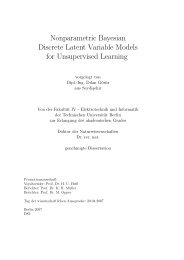Helmholtz Machines and Wake-Sleep Learning - Gatsby ...
Helmholtz Machines and Wake-Sleep Learning - Gatsby ...
Helmholtz Machines and Wake-Sleep Learning - Gatsby ...
You also want an ePaper? Increase the reach of your titles
YUMPU automatically turns print PDFs into web optimized ePapers that Google loves.
units in the lowest layer of the network are observable, in the sense that it<br />
is on them that the inputs are presented; units higher up in the network are<br />
latent, since they are not directly observable from inputs. The second issue<br />
for an analysis by synthesis model is how new inputs are analyzed or recognized<br />
in the light of this generative model, ie how the states of the latent<br />
units are determined so that the input is represented in terms of the way<br />
that it would be generated by the generative model. For the <strong>Helmholtz</strong><br />
machine, this is done in an approximate fashion using a second structured<br />
belief network (called the recognition model) over the latent units, whose<br />
parameters are also learned. The recognition network is a model for the<br />
st<strong>and</strong>ard, bottom-up, connections in cortex. The third issue is the way<br />
that the generative <strong>and</strong> recognition models are learned from data. For<br />
the wake-sleep learning algorithm for the stochastic <strong>Helmholtz</strong> machine<br />
(Hinton et al 1995), this happens in two phases. In the wake phase, the<br />
recognition model is used to estimate the underlying generators (ie the<br />
states of the latent units) for a particular input pattern, <strong>and</strong> then the generative<br />
model is altered so that those generators are more likely to have<br />
produced the input that is actually observed. In the sleep phase, the generative<br />
model fantasizes inputs by choosing particular generators stochastically,<br />
<strong>and</strong> then the recognition model is altered so that it is more likely to<br />
report those particular generators, if the fantasized input were actually to<br />
be observed.<br />
2 The Generative Model<br />
Figure 1 shows an example of a three layer <strong>Helmholtz</strong> machine, involving<br />
(for the sake of simplicity) binary, stochastic, units. The generative model<br />
uses top-down biases <strong>and</strong> weights Ü Ý ÜÝ Ý to parameterize<br />
a probability distribution over the input units . In this<br />
model, the units within each layer are conditionally independent given the<br />
3
















